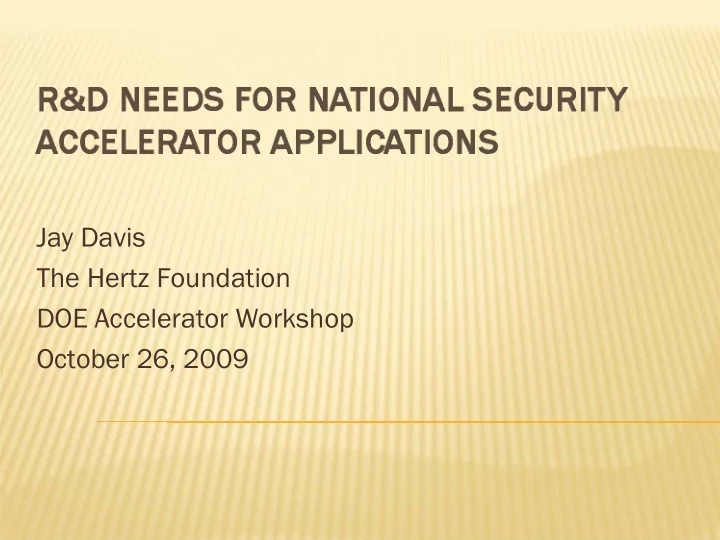

Jay Davis The Hertz Foundation DOE Accelerator Workshop October 26, 2009
� At various times I have built or created accelerators and their applied programs � Seven total at LLNL over three decades � At various other times, I have done national security work as an inspector � Iraq in 1991, Russia, Ukraine and Poland in 1998 � For three years, I headed DTRA, lasing treaty inspections and response to WMD technologies � At present, I sadly do mostly policy studies Outrageous statements will helpfully be placed in red text
� Understanding origins – forensics � Imaging materials in motion – radiography and tomography � Materials modification – causing or understanding damage or alteration � Detecting materials – inventory or interrogations 1. I doubt that there are any credible weapons applications
� Expressing challenges or opportunity � Creating “desirements” for hardware � Suggesting needed R&D � I‘m good at the questions, less so at the answers
� Mass spectrometers and electron microscopes are at one end � Neutron sources for NIF detector characterization are at the other � If it has an ion source or electron gun and a potential drop or an RF field, we should include and assess it
� For conventional mass spectrometers and accelerator mass spectrometry, we need � Fast sample prep methods � Coupling LC and GC systems to ion sources for biological samples � Clever and/or automated sample selection and preparation means for nuclear forensics � For materials characterization, particularly in biology, we need better non-destructive means to place samples in vacuum � Multiple intercompared platforms to meet legal requirements
� We will always want the ability to image at the smallest scale (not well known in advance) at the highest possible speed. Thus � Brighter ion sources � Higher energies � Spectrometric detector systems with greater acceptance A next generation purpose-built pRad machine is greatly to be desired
� An accelerator-driven pulsed low enrichment uranium assembly to replace fast burst reactors for weapons effects research � Multiple ion beam simultaneous irradiation capabilities to simulate fusion or fast reactor conditions in materials � Perhaps a new 14 MeV neutron source for fusion materials work 2. These last two are at the edge of my franchise unless you believe fusion bears on national security
� The next sequence of nuclear arms control treaties will require: � Warhead counting � Inventory verification � Dismantlement verification � A fissile materials cutoff treaty � The varying issues of classification, non- proliferation safeguards, and security restraints impose real limitations on the use of passive detector systems � Can we make clever and uniquely capable probing radiation sources so the detectors can be dumb?
� We all fancy using radiation sources and detectors to find bad things � I think they can work very well in constrained (i.e., treaty-mandated applications) � Sandia’s Cargo Scan at Votkinsk has been a real success � I am dubious about their real utility against terrorists � To me, they are mostly just expensive and vulnerable triggering devices
� Let’s create some taxonomy of applications � Pick out one or two accelerator systems for each application that look promising � Address the inadequacies of what we have � Identify the research needs that would improve the concept � Look laterally across all applications for commonalities that would help us in setting resource priorities
Recommend
More recommend